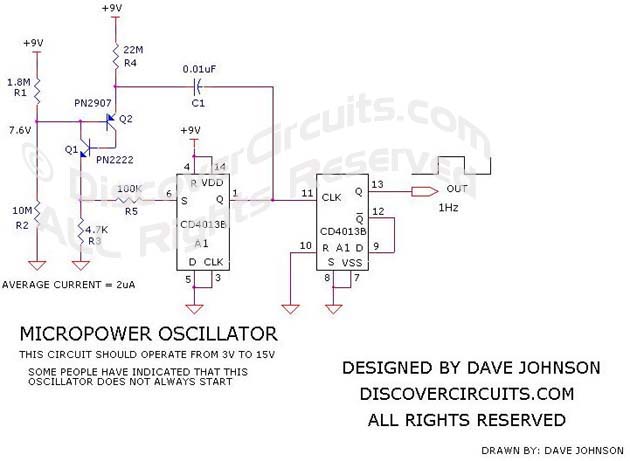|
 |
DiscoverCircuits.com -- Hobby Corner
Last Updated on:
Tuesday, June 01, 2021 03:06 PM
Hobby Circuits List
The contents &
graphics of Discovercircuits.com are copyright protected.
LINK to Dave's circuit, but DO NOT COPY any files to your WEB
SITE server |
|
|
|
|
More
Astable Oscillator Ultra Low Current Oscillator #4
-- January 28, 2010
The circuit below was inspired by a programmable unjunction transistor (PUJT)
circuit sent to me by Karl Isbrecht. In Karl’s circuit, the unijunction
circuit made click sounds in a speaker and consumed very little power. His
circuit reminded me that a PUJT circuit could be made using a couple common
transistors wired in a configuration like a SCR. In the circuit below, the
output of the two transistor pulse generator is connected to a CD4013 dual
flip/flop. One flip/flop is configured as a non-inverting buffer. The
second is wired as conventional divide by two counter. The result is a nice
low frequency square wave generator, which draws only 2ua from a 9v supply.
The circuit will also work with a DC supply voltage ranging from 3v to 15v.
|
|
| The circuit
below was inspired by a programmable unjunction transistor (PUJT) circuit sent to me by
Karl Isbrecht. In Karl’s circuit, the unijunction circuit made click sounds in a
speaker and consumed very little power. His circuit reminded me that a PUJT
circuit could be made using a couple common transistors wired in a configuration like a
SCR. In the circuit below, the output of the two transistor pulse generator is
connected to a CD4013 dual flip/flop. One flip/flop is configured as a
non-inverting buffer. The second is wired as conventional divide by two counter.
The result is a nice low frequency square wave generator, which draws only 2ua from a 9v
supply. The circuit will also work with a DC supply voltage ranging from 3v to
15v. |
|
|
The two transistor pulse generator
circuit is biased to about the ¾ supply level. A high value resistor is used
to charge up a small capacitor. When the capacitor reaches a voltage slightly
above the bias voltage, the PNP transistor starts to conduct. Current from
that part is fed to the base of the second NPN transistor. The collector of
the second transistor is connected to the base of the PNP, so the second NPN
transistor turns on the PNP transistor even harder. This current feedback
causes the circuit to quickly snap into full conduction, which results in the
discharge of the capacitor into the resistor R3. The voltage that appears at
R3 is connected to the set input of the CD4013. With the configuration shown,
the voltage at R3 produces a similar voltage at the Q output. |
|
| The Q output is
connected to the charging capacitor, so the capacitor is discharged and charged up
slightly negative. The positive feedback aids in maintaining oscillation.
The output of the first half of the CD4013 is connected to the other half. That
side is configured as a classic divide by two counter. So, each pulse produced by
the oscillator produces a state change in the flip/flop. With the component values
shown, the circuit produces a very clear 1Hz square wave signal. |
| |
|
Click on Circuit Below to view PDF of Schematic |
|
 |
|
|
|
More Astable
Oscillator
Hobby Circuits List
eMail David A.
Johnson, P.E. about this circuit |